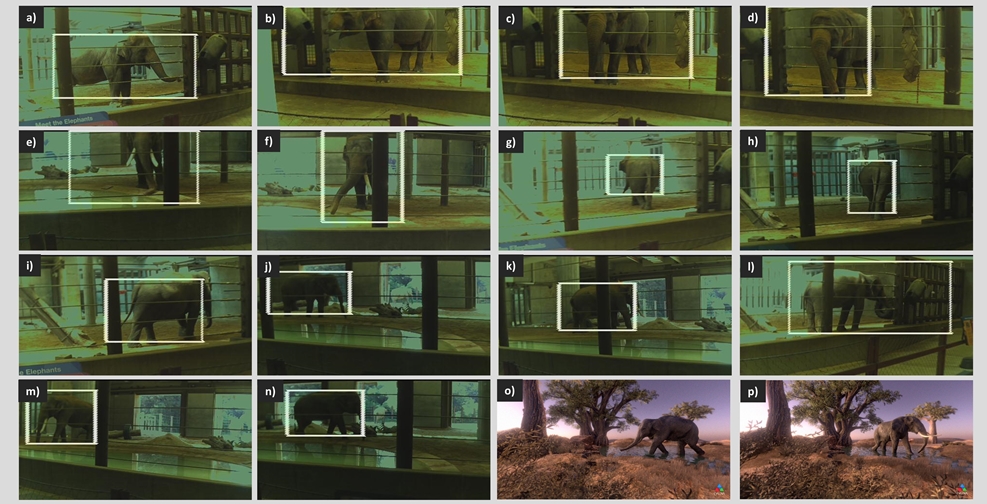WildEyes AI: helping to save wild elephants and prevent human-elephant conflict
On World Elephant Day 2020, two organizations came together to announce a new technology-advanced system to to reduce harm to wild elephants and the humans who live near them. Called WildEyes™ AI, the system involves small cameras that work remotely, hidden in a tree above the reach of elephants, and when the camera’s motion sensor is triggered, it uses computer vision to detect elephants in the frame and transmits those images in near-real time to the cell phones of village guardians. Developed by the NGO RESOLVE and the AI software company CVEDIA, the scalable, low-cost system funded in part by One Earth uses new advances in artificial intelligence technology to detect elephants and transmit alerts to wildlife managers and communities to prevent conflict situations before they occur.

Results from field testing WildEyes AI, running the RESOLVE-CVEDIA Elephant Detector, on Asian Elephants at the Smithsonian National Zoo in Washington, DC. WildEyes AI was able to accurately identify elephants in a variety of poses—including the front, rear, and side profiles—and despite partial obstructions by the bars or posts of the fence. WildEyes AI transmitted photos of positive elephant detections via the GSM Comms Unit as email and text message alerts to RESOLVE staff. The model was trained using synthetic data from CVEDIA, who created 3D renditions for elephants in Asia (o) and Africa (p). RESOLVE.
Over the past two decades, human-elephant conflict has become a major cause of population declines of these supreme mammals in Asia and Africa. Endangered elephants are often killed by civilians protecting their crops from raiding elephants. The conflict threatens community livelihoods, food security, and can even lead to human fatalities. The resulting economic stress to marginalized rural communities causes over $10 million in crop and property damage annually in Sri Lanka and $600,000 worth of crop damage in Tanzania in 2019.
Enhancing elephant monitoring through non-invasive technology can help sow harmony between human and elephant populations. With WildEyes AI, a sophisticated artificial intelligence algorithm detects elephants based on synthetic data models created by CVEDIA, running on the Intel Movidius vision processing unit (VPU) embedded in the WildEyes AI camera. The camera remains asleep until the motion sensor is triggered and then, leveraging the AI algorithm, the Intel VPU filters out false triggers. By filtering “on the edge” i.e., only transmitting true positives of elephants, the camera conserves vital battery life. Due to the VPU’s low power requirements, WildEyes AI can run for more than 1.5 years on a single charge of its small rechargeable Lithium Ion battery—previously unheard of for a field-based sensor. The image of the elephants can be sent over a GSM network, or via a long-range radio link in areas without cell connectivity, in under two minutes from the camera, to the Internet, and back to the local guardians, completing the loop.
With prior knowledge that elephants may be approaching, rangers and villagers will be able respond before elephants raid crops, destroy homes, or endanger local villagers, by using traditional acoustic techniques to scare elephants away, or strengthening physical barrier systems around fields.

Advanced Detection of the Three Elephant Species Using AI on the Edge. This panel of images illustrates inference results from CVEDIA’s Elephant Detector. The detector is agnostic to the species of elephant, so it can accurately detect African savanna elephant, African forest elephant, or Asian elephant. It can detect multiple elephants in the same frame, such as the crop-raiding bulls in the “Gang of Ganga” (m-p) from northern India. The CVEDIA Elephant Detector will run ‘on the edge’, i.e. in the WildEyes AI camera, and allow near-real time transmission of the detections to alert farmers and rangers of approaching threats and instigate deterrents. A key advantage of the system is that the detector is agnostic to camera angle. Thus, the detector can successfully identify elephants even when the camera is positioned >15' in a tree and out of reach of elephants that sometimes seek out and destroy cameras placed near the ground (b-c). RESOLVE.
Extended Elephant Monitoring
The AI elephant detector can also be used to advance the management of elephant populations in tropical forests in Africa and Asia. Current monitoring approaches are resource intensive and dense forested environments where the majority of African forest elephants and Asian elephants reside create too many limitations for timely detection. However, a network of cameras running the CVEDIA elephant detector strategically positioned within elephant home ranges can autonomously detect elephants 24/7 with high accuracy and near real-time notification capabilities, an affordable alternative to traditional surveys or to support existing monitoring efforts.
The CVEDIA elephant detector has the ability to identify all three elephant species: Asian elephant (Elephas maximus), African savanna elephant (Loxodonta africana), and African forest elephant (Loxodonta cyclotis). Release of cameras running the CVEDIA elephant detector will begin in early September 2020. This work was supported by grants from the Shared Earth Foundation, the Stadler Family Foundation, the Weeden Foundation, and One Earth Philanthropy.

.png?auto=compress%2Cformat&w=200)

